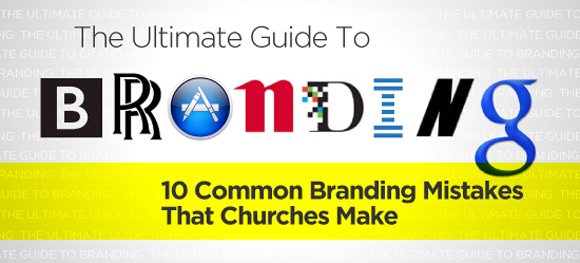Effective branding for churches has never been more important. We live in a media-driven age where first impressions last and a church’s brand presence can literally be the difference someone coming to visit a church or not. A church ‘brand’ is so much more than just the logo. It’s also the language that is used, the visual look and feel around the logo, the kinds of photos used. Ultimately a successful church brand can be defined by the power and focus of the story you tell.
Phil Cooke is the author of Branding Faith defines a brand this way “It’s about the story that surrounds who you are – a story that creates focus for your ministry.” (You can buy his updated book called Unique, I’ve already pre-ordered it!)
Here are some of the common mistakes I’ve seen churches and ministries make with their branding:
1. A logo has to be an all encompassing theological statement
I’ve seen this so many times where the logo looks like it is two or three completely different concepts that were presented by the graphic designer mashed-up together to create the logo so that it covers every point of the most important parts of a church’s theology. A logo (or brand mark as some people call them) doesn’t need to say everything, just one thing that is really at the core of what your church is about.
2. There HAS to be a cross
Disagree? The early church didn’t use the cross to identify itself. It used a fish. Sure you can creatively use a cross in many ways and that’s fine, but if you have a clean slate you don’t need to be locked into having a cross in your church logo.
3. Logo’s are best designed by committees
A committee isn’t the best place to agree on a clear visual direction. There is always such a diverse number of views you nearly always will end up with #1. I’m not saying that your new church logo needs to be an autocratic decision, but the people you put in the decision-making process need to be the right people, not a crowd.
4. Use large/successful church names in a church name
If I had a dollar for every time I see a church with the words WillowBackPointeSongHillC3CreekSaddleNorthEvelate.tv in it I would be a millionaire. Don’t be a carbon copy of another church. There are many relevant names that your church can use. Linking your name to a successful church just is setting yourself up to fail. Rather ask yourself what is it that makes us distinctive? What is the story we have to tell?
On a side note, I’ve seen really awful names that don’t copy a large church. I recently saw a church called the True Jesus church. Honestly what were they thinking? That people are driving around looking for churches and thinking that’s a church we must visit because it’s the True Jesus church, not like that other church that obviously is the pretend Jesus church. If you think that is a bad name for a church check out this list I blogged about a few years ago. There are also a few handy hints to a healthy process in deciding what your church is called.
5. The building is the hero photo
Want to make your brochure and website really come alive? Put your church building on it!
No. Don’t. Please.
The church is about people, not a building. Visitors are not interested in your building, they are interested in your story, community, faith expression, what you stand for, why you exist, not a building.
6. The Pastor is the hero photo
See previous rationale.
7. Use Acronyms
I’ve seen something like this before. “Come along to B.A.S.E it’s going to be epic!’ I was taught at a very early branding Padawan age, if the acronym isn’t in your common culture (not church culture, but the wider culture) then don’t use an acronym. A great way to exclude new people from the life of your church.
8. Only use trendy names
This is similar to #7. I also see mostly generational ministries use trendy, abstract names which is fine, if you lead with the generational age group rather than the name. For example ‘Are you a teenager?Come along to Vibe and connect into community on Tuesdays’. Don’t do this ‘Come along to Vibe and connect into community on Tuesdays’.
9. Use words that don’t reflect who you really are
Words like, contemporary, inclusive, edgy, traditional, young families, teenagers all describe a point in life or a way of expressing how you ‘do’ church. If you are going to summarise yourself in these ways then you need to be accurate. If you say that you are a church for young families, you better have lots of young families and not just aspire to having them.
10. Only talk about your church
Instead of websites or marketing collateral that just talk about their own church is about, church leaders need to ask what are the meaningful ways they can be of service? Is it a life stage, or a pain point where their church can help bring healing. It’s not just about what a church is about, but how a church can help.
Your turn
What common branding mistakes have you seen and what would you do to fix it? Comment below.






